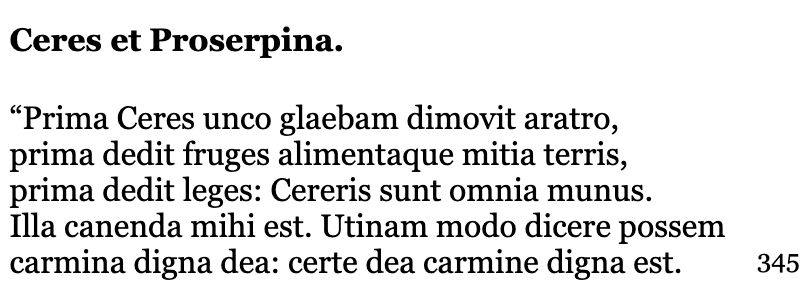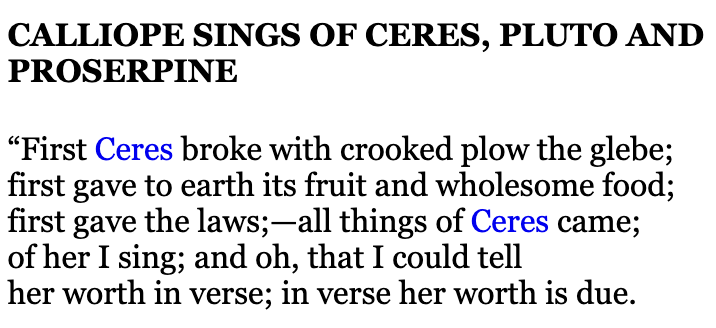Fresh Batch #197: Rites of Ceres
Campus, Osiris, Perseus, Parrhasius Ursa, Persians
Ovid wrote (Metam. L. 5. V. 341.), “Ceres was the first to loosen the earth with a shovel and then a plow, the first to nourish the fertile earth and yield crops, as well as the first to give laws.” (I gave a common sense translation, not a poetic translation, from: Prima Ceres unco glaebam terram dimovit aratro, prima dedit fruges alimentaque mitia terris, prima dedit leges.)
On the subject of Ceres, Jacob Bryant wrote (Analysis of Ancient Mythology, Vol. 2. p. 38.), “The Deity, to whom she was a substitute, was El (אל; Al),the Sun. He was primarily worshiped in these temples: and I have shown, that they were from Achor denominated Acherontian; also temples of Ops, and Oupis, the great serpent God. hence it is said by Hesychius, that Acheron, and Ops, and Helle, and Gerys, and Terra, and Demeter, were the same. Ceres was the Deity of fire: hence at Cnidus she was called Κυρα, (Cura; Kyra; Cœlius. Rhodog. L. 17. c. 27.), a title of the Sun. Her Roman name Ceres, expressed by Hesychius Gerys, was by the Dorians more properly rendered Garys. (Varro speaks of Ceres, as if her name was originally Geres. L. 4. p. 18.)”
Varro allegedly existed in 2nd-1st centuries BC, so the G had been introduced to Italian culture by then. However, prior to that, the C functioned like a G, which is why G and C, or K, are interchangeable in ancient languages and alphabets. So it is likely that Ceres was pronounced Gerys. Also recall that the Persian name for the sun was Kyros, Kyrou, and Kyron, which if entertaining the K to G interchange, would’ve been Gyros, Gyrou, and Gyron. (Κυρον γαρ καλειν Περσας τον Ηλιον. Plutarch, Artaxerxes, circa 75 AD.)
Bryant continued (Ib. p. 38.), “It was originally a city, called Χαρις (Charis, translating as Grace; hence Eu-Charis being Eucharist, or Good Grace): for many of the Deities were erroneously called by the names of the places where they worshiped.”
Bryant claimed (Ib. p. 39.) that the towers of Ceres were Prytaneia, which were initially fire towers, confused by the Greeks as πυρου ταμειον, literally grain fund, or granary. (Recall wheat [πυρός] and fire are the same word in Greek, and that corn originally meant grain or seed, not maize, so when you read that Ceres was the Goddess of Corn, it’s literally the Goddess of Grain). This confusion, according to Bryant, led the Greeks to interpret temples of Orus as granaries of corn. However, this may not been a misinterpretation, as we see the Pictish Towers and the Nuraghic Towers having possible similar functions. Revisit the following article for the similarity of towers found in Britain and Sardinia (Sardegna).
Fresh Batch #37: Does Architecture in Sardegna, Arizona, Britain, Spain, and Peru Indicate Diffusion of an Ancient Universal Empire?
Masonry techniques are something that I think ought to be focused on in trying to discover diffusion between cultures in the ancient past. However, the secret nature of these techniques has likely caused the knowledge of the Old World masonry to be lost, especially with the invention of canons that made the building of stone castles and edifices obsolete as warfare modernized. That being said, no two Greek temples and no two Egyptian or American pyramids are exactly alike as far as I can tell. There are always variations. So why should any stone structure that may prove diffusion be exactly alike?
Bryant wrote (Ib. p. 41.), “Many of these temples were dedicated to the Deity under the name of Persephone, or Proserpine, the supposed daughter of Ceres. They were in reality the same personage. Persephone was styled Κορα, Cora; which the Greeks misinterpreted Παρθενος (Parthenos), the virgin, or damsel. How could a person, who according to the received accounts had been ravished by Pluto, and been his consort for ages; who was the reputed queen of hell, be styled by way of eminence Παρθενος? Κορα, Cora, which they understood was the same as Cura, a feminine title of the Sun: by which Ceres was also called Cnidos. However mild and gentle Proserpine may have been represented in her virgin state by the Poets; yet her tribunal seems in many places to have been very formidable. In consequence of this we find her with Minos, and Rhadamanthus, condemned to the shades below, as an infernal inquisitor.”
Bryant doesn’t seem to have the astronomical knowledge to explain this, or he chose to omit it. But if you comprehend the symbolism of winter being allegorized as hell, the abyss, the shades below, etc., as well as those male archetypes representing the sun in winter, and the signs or months the sun moves through during that portion of the year, then it’s quite easy to see the signification of a maiden being carried away, which is that the virgin archetype represents Virgo, who began her reign as Lord of the Ascendant at the beginning of winter, and then ruled the winter skies, making her way towards the midheaven by dawn. You can observe this today, but must account for the degrees of precession to know where Virgo was thousands of years ago, which is the value of creating and maintaining the Tropical system. These subjects are treated in great detail in the Spirit Whirled series, along with the historical implications of being able to track this system in different regions only accessible by maritime travel.







Become a member to access the rest of this article.
Keep reading with a 7-day free trial
Subscribe to Ancient History, Mythology, & Epic Fantasy to keep reading this post and get 7 days of free access to the full post archives.







